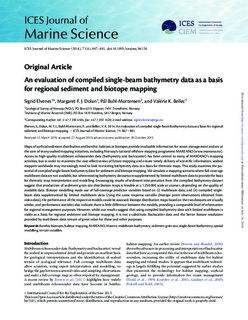| dc.contributor.author | Elvenes, Sigrid | |
| dc.contributor.author | Dolan, Margaret F. J. | |
| dc.contributor.author | Buhl-Mortensen, Pål | |
| dc.contributor.author | Bellec, Valerie K. | |
| dc.date.accessioned | 2014-07-16T09:11:34Z | |
| dc.date.available | 2014-07-16T09:11:34Z | |
| dc.date.issued | 2013-10-18 | |
| dc.identifier.citation | Elvenes, S., Dolan, M. F. J., Buhl-Mortensen, P., and Bellec, V. K. 2014. An evaluation of compiled single-beam bathymetry data as a basis for regional sediment and biotope mapping. – ICES Journal of Marine Science, 71: 867–881 | nb_NO |
| dc.identifier.issn | 1054-3139 | |
| dc.identifier.issn | 1095-9289 | |
| dc.identifier.uri | http://hdl.handle.net/11250/197472 | |
| dc.description.abstract | Maps of surficial sediment distribution and benthic habitats or biotopes provide invaluable information for ocean management and are at the core of many seabed mapping initiatives, including Norway's national offshore mapping programme MAREANO (www.mareano.no). Access to high-quality multibeam echosounder data (bathymetry and backscatter) has been central to many of MAREANO's mapping activities, but in order to maximize the cost-effectiveness of future mapping and ensure timely delivery of scientific information, seabed mappers worldwide may increasingly need to look to existing bathymetry data as a basis for thematic maps. This study examines the potential of compiled single-beam bathymetry data for sediment and biotope mapping. We simulate a mapping scenario where full coverage multibeam data are not available, but where existing bathymetry datasets are supplemented by limited multibeam data to provide the basis for thematic map interpretation and modelling. Encouraging results of sediment interpretation from the compiled bathymetry dataset suggest that production of sediment grain size distribution maps is feasible at a 1:250 000 scale or coarser, depending on the quality of available data. Biotope modelling made use of full-coverage predictor variables based on (i) multibeam data, and (ii) compiled single-beam data supplemented by limited multibeam data. Using the same response variable (biotope point observations obtained from video data), the performance of the respective models could be assessed. Biotope distribution maps based on the two datasets are visually similar, and performance statistics also indicate there is little difference between the models, providing a comparable level of information for regional management purposes. However, whilst our results suggest that using compiled bathymetry data with limited multibeam is viable as a basis for regional sediment and biotope mapping, it is not a substitute. Backscatter data and the better feature resolution provided by multibeam data remain of great value for these and other purposes. | nb_NO |
| dc.language.iso | eng | nb_NO |
| dc.publisher | Oxford Journals | nb_NO |
| dc.subject | VDP::Landbruks- og Fiskerifag: 900::Fiskerifag: 920::Ressursbiologi: 921 | nb_NO |
| dc.title | An evaluation of compiled single-beam bathymetry data as a basis for regional sediment and biotope mapping | nb_NO |
| dc.type | Journal article | nb_NO |
| dc.type | Peer reviewed | nb_NO |
| dc.source.pagenumber | 867-881 | nb_NO |
| dc.source.volume | 71 | nb_NO |
| dc.source.journal | ICES Journal of Marine Science | nb_NO |
| dc.source.issue | 4 | nb_NO |
| dc.identifier.doi | 10.1093/icesjms/fst154 | |
